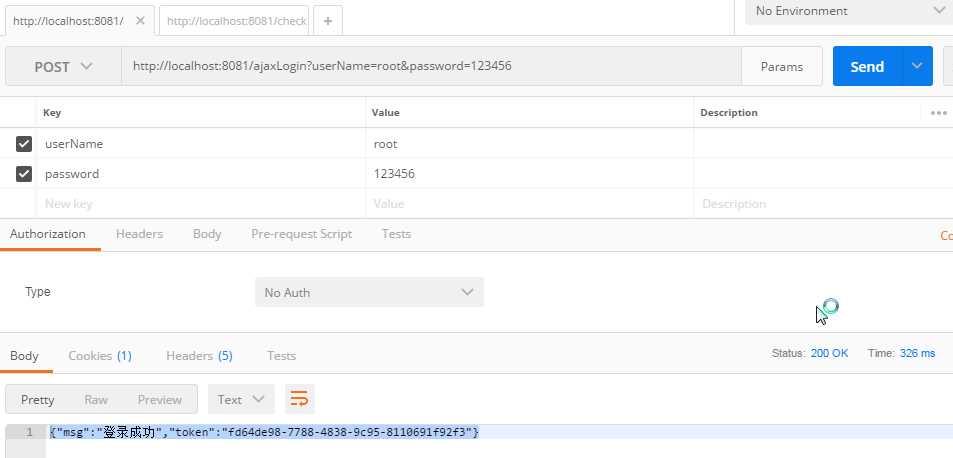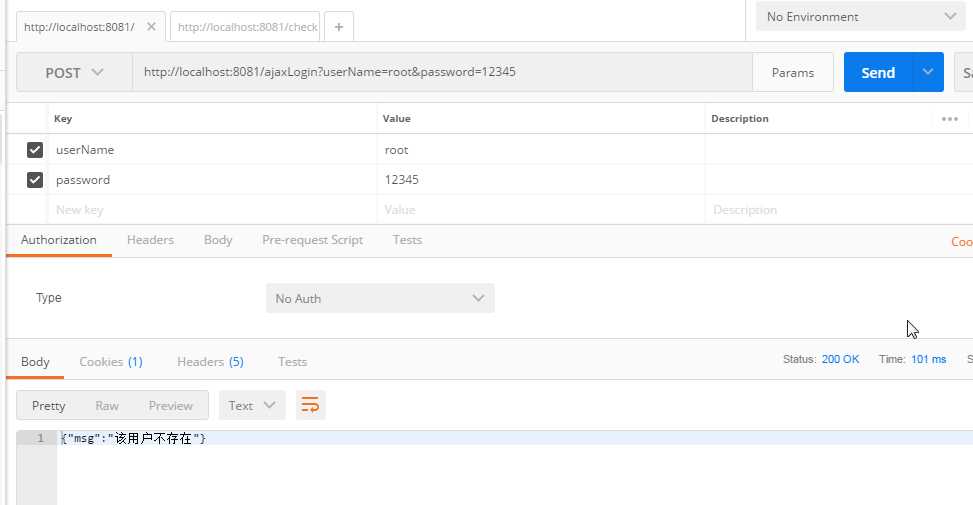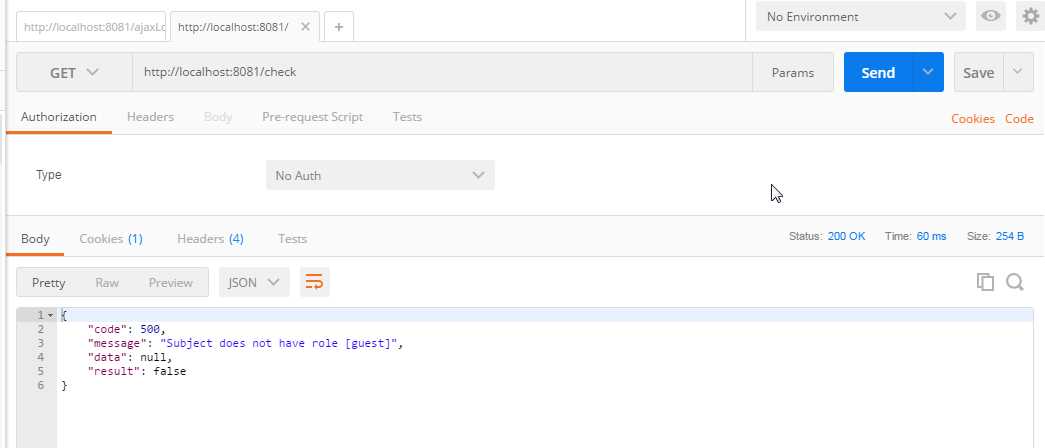SpringBoot整合Shiro自定義Redis存儲
Shiro
Shiro 主要分為 安全認證 和 接口授權 兩個部分,其中的核心組件為 Subject、 SecurityManager、 Realms,公共部分 Shiro 都已經為我們封裝好了,我們只需要按照一定的規則去編寫響應的代碼即可…
Subject 表示主體,將用戶的概念理解為當前操作的主體,它即可以是一個通過瀏覽器請求的用戶,也可能是一個運行的程序,外部應用與 Subject 進行交互,記錄當前操作用戶。Subject 代表當前用戶的安全操作,SecurityManager 則管理所有用戶的安全操作。
SecurityManager 即安全管理器,對所有的 Subject 進行安全管理,並通過它來提供安全管理的各種服務(認證、授權等)
Realm 充當了應用與數據安全間的 橋梁 或 連接器。當對用戶執行認證(登錄)和授權(訪問控制)驗證時,Shiro 會從應用配置的 Realm 中查找用戶及其權限信息。
1.導入shiro依賴

<dependency>
<groupId>org.apache.shiro</groupId>
<artifactId>shiro-spring</artifactId>
<version>1.4.0</version>
</dependency>
<dependency>
<groupId>org.crazycake</groupId>
<artifactId>shiro-redis</artifactId>
<version>2.8.24</version>
</dependency>

2.shiro配置類

import org.apache.shiro.authc.credential.HashedCredentialsMatcher;
import org.apache.shiro.mgt.SecurityManager;
import org.apache.shiro.session.mgt.SessionManager;
import org.apache.shiro.spring.security.interceptor.AuthorizationAttributeSourceAdvisor;
import org.apache.shiro.spring.web.ShiroFilterFactoryBean;
import org.apache.shiro.web.mgt.DefaultWebSecurityManager;
import org.crazycake.shiro.RedisCacheManager;
import org.crazycake.shiro.RedisManager;
import org.crazycake.shiro.RedisSessionDAO;
import org.springframework.aop.framework.autoproxy.DefaultAdvisorAutoProxyCreator;
import org.springframework.beans.factory.annotation.Value;
import org.springframework.context.annotation.Bean;
import org.springframework.context.annotation.Configuration;
import org.springframework.web.servlet.HandlerExceptionResolver;
import java.util.LinkedHashMap;
import java.util.Map;
@Configuration
public class ShiroConfig {
@Value("${spring.redis.shiro.host}")
private String host;
@Value("${spring.redis.shiro.port}")
private int port;
@Value("${spring.redis.shiro.timeout}")
private int timeout;
@Value("${spring.redis.shiro.password}")
private String password;
@Bean
public ShiroFilterFactoryBean shirFilter(SecurityManager securityManager) {
System.out.println("ShiroConfiguration.shirFilter()");
ShiroFilterFactoryBean shiroFilterFactoryBean = new ShiroFilterFactoryBean();
shiroFilterFactoryBean.setSecurityManager(securityManager);
Map<String, String> filterChainDefinitionMap = new LinkedHashMap<String, String>();
// 註意過濾器配置順序 不能顛倒
// 配置退出 過濾器,其中的具體的退出代碼Shiro已經替我們實現了,登出後跳轉配置的loginUrl
filterChainDefinitionMap.put("/logout", "logout");
// 配置不會被攔截的鏈接 順序判斷,在 ShiroConfiguration 中的 shiroFilter 處配置了 /ajaxLogin=anon,意味著可以不需要認證也可以訪問
filterChainDefinitionMap.put("/static/**", "anon");
filterChainDefinitionMap.put("/*.html", "anon");
filterChainDefinitionMap.put("/ajaxLogin", "anon");
filterChainDefinitionMap.put("/login", "anon");
filterChainDefinitionMap.put("/**", "authc");
// 配置shiro默認登錄界面地址,前後端分離中登錄界面跳轉應由前端路由控制,後臺僅返回json數據
shiroFilterFactoryBean.setLoginUrl("/unauth");
// 登錄成功後要跳轉的鏈接
// shiroFilterFactoryBean.setSuccessUrl("/index");
// 未授權界面;
// shiroFilterFactoryBean.setUnauthorizedUrl("/403");
shiroFilterFactoryBean.setFilterChainDefinitionMap(filterChainDefinitionMap);
return shiroFilterFactoryBean;
}
/**
* 憑證匹配器
* (由於我們的密碼校驗交給Shiro的SimpleAuthenticationInfo進行處理了)
*
* @return
*/
@Bean
public HashedCredentialsMatcher hashedCredentialsMatcher() {
HashedCredentialsMatcher hashedCredentialsMatcher = new HashedCredentialsMatcher();
hashedCredentialsMatcher.setHashAlgorithmName("md5");//散列算法:這裏使用MD5算法;
hashedCredentialsMatcher.setHashIterations(1024);//散列的次數,比如散列兩次,相當於 md5(md5(""));
return hashedCredentialsMatcher;
}
@Bean
public MyShiroRealm myShiroRealm() {
MyShiroRealm myShiroRealm = new MyShiroRealm();
myShiroRealm.setCredentialsMatcher(hashedCredentialsMatcher());
return myShiroRealm;
}
@Bean
public SecurityManager securityManager() {
DefaultWebSecurityManager securityManager = new DefaultWebSecurityManager();
securityManager.setRealm(myShiroRealm());
// 自定義session管理 使用redis
securityManager.setSessionManager(sessionManager());
// 自定義緩存實現 使用redis
securityManager.setCacheManager(cacheManager());
return securityManager;
}
//自定義sessionManager
@Bean
public SessionManager sessionManager() {
MySessionManager mySessionManager = new MySessionManager();
mySessionManager.setSessionDAO(redisSessionDAO());
return mySessionManager;
}
/**
* 配置shiro redisManager
*
* 使用的是shiro-redis開源插件
*
* @return
*/
public RedisManager redisManager() {
RedisManager redisManager = new RedisManager();
redisManager.setHost(host);
redisManager.setPort(port);
redisManager.setExpire(1800);// 配置緩存過期時間
redisManager.setTimeout(timeout);
redisManager.setPassword(password);
return redisManager;
}
/**
* cacheManager 緩存 redis實現
*
* 使用的是shiro-redis開源插件
*
* @return
*/
@Bean
public RedisCacheManager cacheManager() {
RedisCacheManager redisCacheManager = new RedisCacheManager();
redisCacheManager.setRedisManager(redisManager());
return redisCacheManager;
}
/**
* RedisSessionDAO shiro sessionDao層的實現 通過redis
*
* 使用的是shiro-redis開源插件
*/
@Bean
public RedisSessionDAO redisSessionDAO() {
RedisSessionDAO redisSessionDAO = new RedisSessionDAO();
redisSessionDAO.setRedisManager(redisManager());
return redisSessionDAO;
}
/**
* 開啟shiro aop註解支持.
* 使用代理方式;所以需要開啟代碼支持;
*
* @param securityManager
* @return
*/
@Bean
public AuthorizationAttributeSourceAdvisor authorizationAttributeSourceAdvisor(SecurityManager securityManager) {
AuthorizationAttributeSourceAdvisor authorizationAttributeSourceAdvisor = new AuthorizationAttributeSourceAdvisor();
authorizationAttributeSourceAdvisor.setSecurityManager(securityManager);
return authorizationAttributeSourceAdvisor;
}
/**
* 註冊全局異常處理
* @return
*/
@Bean(name = "exceptionHandler")
public HandlerExceptionResolver handlerExceptionResolver() {
return new MyExceptionHandler();
}
//自動創建代理,沒有這個鑒權可能會出錯
@Bean
public DefaultAdvisorAutoProxyCreator getDefaultAdvisorAutoProxyCreator() {
DefaultAdvisorAutoProxyCreator autoProxyCreator = new DefaultAdvisorAutoProxyCreator();
autoProxyCreator.setProxyTargetClass(true);
return autoProxyCreator;
}
}
3.安全認證和權限驗證的核心,自定義Realm

import com.google.gson.JsonObject;
import com.test.cbd.service.UserService;
import com.test.cbd.vo.SysPermission;
import com.test.cbd.vo.SysRole;
import com.test.cbd.vo.UserInfo;
import org.apache.commons.beanutils.BeanUtils;
import org.apache.shiro.SecurityUtils;
import org.apache.shiro.authc.*;
import org.apache.shiro.authz.AuthorizationInfo;
import org.apache.shiro.authz.SimpleAuthorizationInfo;
import org.apache.shiro.realm.AuthorizingRealm;
import org.apache.shiro.session.Session;
import org.apache.shiro.subject.PrincipalCollection;
import org.apache.shiro.subject.Subject;
import org.apache.shiro.util.ByteSource;
import springfox.documentation.spring.web.json.Json;
import javax.annotation.Resource;
import java.util.HashSet;
import java.util.Set;
public class MyShiroRealm extends AuthorizingRealm {
@Resource
private UserService userInfoService;
@Override
protected AuthorizationInfo doGetAuthorizationInfo(PrincipalCollection principals){
// // 權限信息對象info,用來存放查出的用戶的所有的角色(role)及權限(permission)
SimpleAuthorizationInfo authorizationInfo = new SimpleAuthorizationInfo();
Session session = SecurityUtils.getSubject().getSession();
UserInfo user = (UserInfo) session.getAttribute("USER_SESSION");
// 用戶的角色集合
Set<String> roles = new HashSet<>();
roles.add(user.getRoleList().get(0).getRole());
authorizationInfo.setRoles(roles);
return authorizationInfo;
}
/*主要是用來進行身份認證的,也就是說驗證用戶輸入的賬號和密碼是否正確。*/
@Override
protected AuthenticationInfo doGetAuthenticationInfo(AuthenticationToken token)
throws AuthenticationException {
// System.out.println("MyShiroRealm.doGetAuthenticationInfo()");
// 獲取用戶的輸入的賬號.
String username = (String) token.getPrincipal();
// System.out.println(token.getCredentials());
// 通過username從數據庫中查找 User對象,如果找到,沒找到.
// 實際項目中,這裏可以根據實際情況做緩存,如果不做,Shiro自己也是有時間間隔機制,2分鐘內不會重復執行該方法
UserInfo userInfo = userInfoService.findByUsername(username);
// Subject subject = SecurityUtils.getSubject();
// Session session = subject.getSession();
// session.setAttribute("role",userInfo.getRoleList());
// System.out.println("----->>userInfo="+userInfo);
if (userInfo == null) {
return null;
}
if (userInfo.getState() == 1) { //賬戶凍結
throw new LockedAccountException();
}
String credentials = userInfo.getPassword();
System.out.println("credentials="+credentials);
ByteSource credentialsSalt = ByteSource.Util.bytes(username);
SimpleAuthenticationInfo authenticationInfo = new SimpleAuthenticationInfo(
userInfo.getUserName(), //用戶名
credentials, //密碼
credentialsSalt,
getName() //realm name
);
Session session = SecurityUtils.getSubject().getSession();
session.setAttribute("USER_SESSION", userInfo);
return authenticationInfo;
}
}

4.全局異常處理器

import com.alibaba.fastjson.support.spring.FastJsonJsonView;
import org.apache.shiro.authz.UnauthenticatedException;
import org.apache.shiro.authz.UnauthorizedException;
import org.springframework.web.servlet.HandlerExceptionResolver;
import org.springframework.web.servlet.ModelAndView;
import javax.servlet.http.HttpServletRequest;
import javax.servlet.http.HttpServletResponse;
import java.util.HashMap;
import java.util.Map;
/**
* Created by Administrator on 2017/12/11.
* 全局異常處理
*/
public class MyExceptionHandler implements HandlerExceptionResolver {
public ModelAndView resolveException(HttpServletRequest httpServletRequest,
HttpServletResponse httpServletResponse, Object o, Exception ex) {
ModelAndView mv = new ModelAndView();
FastJsonJsonView view = new FastJsonJsonView();
Map<String, Object> attributes = new HashMap<String, Object>();
if (ex instanceof UnauthenticatedException) {
attributes.put("code", "1000001");
attributes.put("msg", "token錯誤");
} else if (ex instanceof UnauthorizedException) {
attributes.put("code", "1000002");
attributes.put("msg", "用戶無權限");
} else {
attributes.put("code", "1000003");
attributes.put("msg", ex.getMessage());
}
view.setAttributesMap(attributes);
mv.setView(view);
return mv;
}
}

5.因為現在的項目大多都是前後端分離的,所以我們需要實現自己的session管理

import org.apache.shiro.web.servlet.ShiroHttpServletRequest;
import org.apache.shiro.web.session.mgt.DefaultWebSessionManager;
import org.apache.shiro.web.util.WebUtils;
import org.springframework.util.StringUtils;
import javax.servlet.ServletRequest;
import javax.servlet.ServletResponse;
import java.io.Serializable;
public class MySessionManager extends DefaultWebSessionManager {
private static final String TOKEN = "token";
private static final String REFERENCED_SESSION_ID_SOURCE = "Stateless request";
public MySessionManager() {
super();
}
@Override
protected Serializable getSessionId(ServletRequest request, ServletResponse response) {
String id = WebUtils.toHttp(request).getHeader(TOKEN);
//如果請求頭中有 token 則其值為sessionId
if (!StringUtils.isEmpty(id)) {
request.setAttribute(ShiroHttpServletRequest.REFERENCED_SESSION_ID_SOURCE, REFERENCED_SESSION_ID_SOURCE);
request.setAttribute(ShiroHttpServletRequest.REFERENCED_SESSION_ID, id);
request.setAttribute(ShiroHttpServletRequest.REFERENCED_SESSION_ID_IS_VALID, Boolean.TRUE);
return id;
} else {
//否則按默認規則從cookie取sessionId
return super.getSessionId(request, response);
}
}
}

6.控制器

import com.alibaba.fastjson.JSONObject;
import com.test.cbd.vo.UserInfo;
import io.swagger.annotations.Api;
import lombok.extern.slf4j.Slf4j;
import org.apache.shiro.SecurityUtils;
import org.apache.shiro.authc.AuthenticationException;
import org.apache.shiro.authc.IncorrectCredentialsException;
import org.apache.shiro.authc.LockedAccountException;
import org.apache.shiro.authc.UsernamePasswordToken;
import org.apache.shiro.authz.annotation.RequiresRoles;
import org.apache.shiro.crypto.hash.SimpleHash;
import org.apache.shiro.session.Session;
import org.apache.shiro.subject.Subject;
import org.apache.shiro.util.ByteSource;
import org.springframework.web.bind.annotation.*;
import javax.servlet.http.HttpServletRequest;
import java.net.InetAddress;
@Slf4j
@Api(value="shiro測試",description="shiro測試")
@RestController
@RequestMapping("/")
public class ShiroLoginController {
/**
* 登錄測試
* @param userInfo
* @return
*/
@RequestMapping(value = "/ajaxLogin", method = RequestMethod.POST)
@ResponseBody
public String ajaxLogin(UserInfo userInfo) {
JSONObject jsonObject = new JSONObject();
UsernamePasswordToken token = new UsernamePasswordToken(userInfo.getUserName(), userInfo.getPassword());
Subject subject = SecurityUtils.getSubject();
try {
subject.login(token);
jsonObject.put("token", subject.getSession().getId());
jsonObject.put("msg", "登錄成功");
} catch (IncorrectCredentialsException e) {
jsonObject.put("msg", "密碼錯誤");
} catch (LockedAccountException e) {
jsonObject.put("msg", "登錄失敗,該用戶已被凍結");
} catch (AuthenticationException e) {
jsonObject.put("msg", "該用戶不存在");
} catch (Exception e) {
e.printStackTrace();
}
return jsonObject.toString();
}
/**
* 鑒權測試
* @param userInfo
* @return
*/
@RequestMapping(value = "/check", method = RequestMethod.GET)
@ResponseBody
@RequiresRoles("guest")
public String check() {
JSONObject jsonObject = new JSONObject();
jsonObject.put("msg", "鑒權測試");
return jsonObject.toString();
}
}

常用註解
@RequiresGuest 代表無需認證即可訪問,同理的就是 /path=anon
@RequiresAuthentication 需要認證,只要登錄成功後就允許你操作
@RequiresPermissions 需要特定的權限,沒有則拋出 AuthorizationException
@RequiresRoles 需要特定的橘色,沒有則拋出 AuthorizationException
7.以上就是shiro登陸和鑒權的主要配置和類,下面補充一下其他信息。
①application.properties中shiro-redis相關配置:
spring.redis.shiro.host=127.0.0.1 spring.redis.shiro.port=6379 spring.redis.shiro.timeout=5000 spring.redis.shiro.password=123456
②因為數據是模擬的,所以在登陸認證的時候,並沒有通過數據庫查用戶信息,可以通過以下方式模擬加密後的密碼:

/**
* 生成測試用的md5加密的密碼
* @param args
*/
public static void main(String[] args) {
String hashAlgorithmName = "md5";
String credentials = "123456";//密碼
int hashIterations = 1024;
ByteSource credentialsSalt = ByteSource.Util.bytes("root");//賬號
String obj = new SimpleHash(hashAlgorithmName, credentials, credentialsSalt, hashIterations).toHex();
System.out.println(obj);
}

上面obj的結果是b1ba853525d0f30afe59d2d005aad96c
③登陸認證的findByUsername方法,模擬到數據庫查詢用戶信息,實際是自己構造的數據,偷偷懶。

public UserInfo findByUsername(String userName){
SysRole admin = SysRole.builder().role("admin").build();
List<SysPermission> list=new ArrayList<SysPermission>();
SysPermission sysPermission=new SysPermission("read");
SysPermission sysPermission1=new SysPermission("write");
list.add(sysPermission);
list.add(sysPermission1);
admin.setPermissions(list);
UserInfo root = UserInfo.builder().userName("root").password("b1ba853525d0f30afe59d2d005aad96c").credentialsSalt("123").state(0).build();
List<SysRole> roleList=new ArrayList<SysRole>();
roleList.add(admin);
root.setRoleList(roleList);
return root;
}

8.結果演示
輸入正確的賬號密碼時,返回信息如下:

故意輸錯密碼時,返回信息如下:

鑒權時,如果該用戶沒有角色:

SpringBoot整合Shiro自定義Redis存儲
